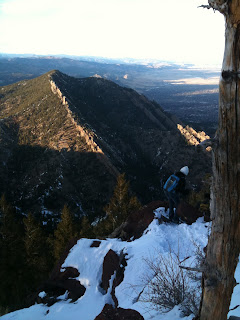I'm not.
For the average person on the street to take off and run fifteen miles because of some dire situation, it would likely require that the person persevere through pain, discomfort, and uncertainty. In many cases the person would even face real issues of life and death. A not tough person in that case would probably give up and drop in despair, whereas a tough person may push on until he or she drops dead.
The untough prepare and condition themselves so they don't land in unfamiliar circumstances related to pain, discomfort, and uncertainty. If I build up to being able to run fifteen miles by first running two, then three, then five, etc. I slowly learn what to expect, what pains and discomforts might be normal and with that I can reduce the uncertainties. Through the conditioning that may take many weeks one gets to the point where they are confident that they can do it and the unknowns are minimized.
So what if I had to run 50 miles, or 100. Would it require toughness at some point or would I be able to prepare and condition myself enough so that I am familiar with the possible pains, discomforts, and uncertainties so that I'd be able to endure them? Let's use a simple common example. I never get blisters, but let's say that sixty miles down the trail I develop some horrendous ones. Being prepared, I may have some means to alleviate the situation somewhat by applying an ointment, in which case a high level of toughness isn't required or I push through the pain, intellectualizing that I only have a superficial irritation and if I can keep my attention elsewhere some natural endorphins may come to the rescue. If I've trained to run 100 miles I'm sure I have experienced having to deal with pain and discomfort so maybe I'd be able to handle blisters.
When do I need to be tough? There could be potential problems with hydration, electrolyte levels, and injuries that physically make it impossible for me to go on even though I resort to crawling forward. Am I tough at that point? If I'm sleep deprived, hallucinating, and vomiting and still able to put one foot in front of the other, am I tough? Or am I still in some kind of comfort zone because I've been here before and putting one foot in front of the other is where I'm most comfortable?
The moment I face an unknown or uncertainty that I can't make familiar, especially if I'm on the edge of physical exhaustion and mentally fragile, I quit, I give up, let me lay down in the fetal position with a beer. I'm not tough; I'm just prepared, conditioned, and experienced.
Long distance runners gain some transfer; we certainly feel comfortable facing challenges on the trail and probably even some challenges away from that realm. Part of pushing our limits is to extend our comfort zone, to be tough so we don't really have to be
tough. For most people, persevering in the face of the unknown is where we may be called upon to be tough, but even then, if we have enough experience facing the unknown, we don't have to be tough.
I teach, and in education I see too many students who are put in a position of having to be tough or quit because they are not prepared, conditioned, and face the unknown. Using a parallel, too often they find themselves being able to run two miles but viewing the next concept or unit as being asked to run twenty and they give up or make excuses. Too often, teachers make assumptions about where students are and ask them to run twenty miles instead of three when they are able to run two.
If I can have control and gradually build up experience and conditioning and not face big unknowns, I'm in, but if I truly have to be tough, I'm going home.

























